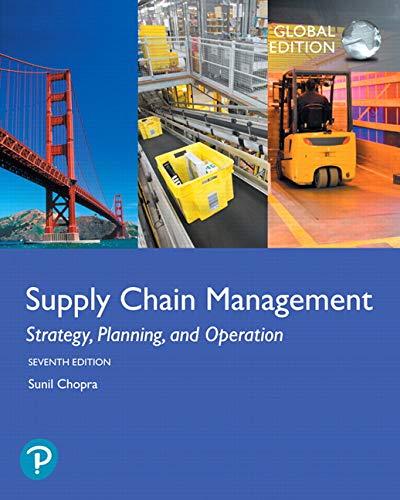Question
Specialty Packaging Corporation Julie Williams had a lot on her mind when she left the conference room at Specialty Packaging Corporation (SPC). Her divisional manager
Specialty Packaging Corporation
Julie Williams had a lot on her mind when she left the conference room at Specialty Packaging Corporation (SPC). Her divisional manager had informed her that she would be assigned to a team consisting of SPC's marketing vice president and staff members from their key customers. The goal of this team was to improve supply chain performance, as SPC had been unable to meet demand effectively over the previous several years. This often left SPC's customers scrambling to meet new client demands. Julie had little contact with SPC's customers and wondered how she would add value to this process. She was told by her division manager that the team's first task was to establish a collaborative forecast using data from both SPC and its customers. This forecast would serve as the basis for improving the firm's performance, as managers could use this more accurate forecast for their production planning. Improved forecasts would allow SPC to improve delivery performance.
SPC turns polystyrene resin into recyclable/disposable containers for the food industry. Polystyrene is purchased as a commodity in the form of resin pellets. The resin is unloaded from bulk rail containers or overland trailers into storage silos. Making the food containers is a two-step process. First, resin is conveyed to an extruder, which converts it into a polystyrene sheet that is wound into rolls. The plastic comes in two formsclear and black. The rolls are either used immediately to make containers or put into storage. Second, the rolls are loaded onto thermoforming presses, which form the sheet into containers and trim the containers from the sheet. Over the past five years, the plastic packaging business has grown steadily. Demand for containers made from clear plastic comes from grocery stores, bakeries, and restaurants. Caterers and grocery stores use the black plastic trays as packaging and serving trays. Demand for clear plastic containers peaks in the summer months, whereas demand for black plastic containers peaks in the fall. Capacity on the extruders is not sufficient to cover demand for sheets during the peak seasons. As a result, the plant is forced to build inventory of each type of sheet in anticipation of future demand. Table 7-4 and Figure 7-12 display historical quarterly demand for each of the two types of containers (clear and black). The team modified SPC's sales data by accounting for lost sales to obtain true demand data. Without the customers involved in this team, SPC would never have known this information, as the company did not keep track of lost orders.
| Year | Quarter | Black Plastic Demand ('000 lbs) | Clear Plastic Demand ('000 lbs) |
| 2005 | I | 2250 | 3200 |
| 2005 | II | 1737 | 7658 |
| 2005 | III | 2412 | 4420 |
| 2005 | IV | 7269 | 2384 |
| 2006 | I | 3514 | 3654 |
| 2006 | II | 2143 | 8680 |
| 2006 | III | 3459 | 5695 |
| 2006 | IV | 7056 | 1953 |
| 2007 | I | 4120 | 4742 |
| 2007 | II | 2766 | 13673 |
| 2007 | III | 2556 | 6640 |
| 2007 | IV | 8253 | 2737 |
| 2008 | I | 5491 | 3486 |
| 2008 | II | 4382 | 13186 |
| 2008 | III | 4315 | 5448 |
| 2008 | IV | 12035 | 3485 |
| 2009 | I | 5648 | 7728 |
| 2009 | II | 3696 | 16591 |
| 2009 | III | 4843 | 8236 |
| 2009 | IV | 13097 | 3316 |
Question 1 - Compare the historical demand for both plastic types and briefly describe their key characteristics and differences. Backtesting is an approach to benchmark the performance of methods on historical data. It involves separating your data into two partitions. The first partition is used for training your method and the second partition is used for testing its performance. In the textbook, we have data for the years 2005 to 2009. We will use the historical demand from 2005 to 2007 as the training data set and the historical demand from 2008 and 2009 as the test data set. Backtesting can be useful to reveal information about performance of methods that cannot be obtained by testing on synthetic demand data. However, it is important to keep in mind that performance on historical data may not be representative of future performance. Nevertheless, backtesting has proven to be quite useful in practice.
Step by Step Solution
There are 3 Steps involved in it
Step: 1

Get Instant Access to Expert-Tailored Solutions
See step-by-step solutions with expert insights and AI powered tools for academic success
Step: 2

Step: 3

Ace Your Homework with AI
Get the answers you need in no time with our AI-driven, step-by-step assistance
Get Started


